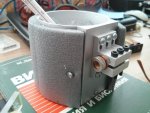- Joined
- Feb 12, 2016
- Messages
- 589
- Points
- 63
During last months I have been playing with Blue-Blue dichro for combining 445 and 462nm checking different types of blue diodes.
Besides multimode LDs I also checked some of highest power single mode ones - among blue and close colours these were of course BDR-209 which according to info found here on LPF should emit at 410-415nm under 600mA, and PLT5 450B emitting at ~447nm under 300mA.
So what I have found is that apart of for combining 445-450nm with 460-465nm, this dichro can very fine work for combining PLT5 450B (92-96% pass) with BDR-209 (80-98% reflection depending on polarisation).
The results for four PLT5 I have tested all with same G-2 lens at 300mA current:
1. 0.23W Pass out of 0.25W before dichro.
2. 0.26W out of 0.27W
3. 0.23W out of 0.24W
4. 0.27-0.28W out of 0.29W
The results for two BDR-209 tested with G-2 at 600mA current:
1. 0.83W Reflection when spot on wall 5 meters away is vertical oval and 0.86W when horisontal oval out of 0.88W.
2. 0.73 and 0.87W out of 0.91W correspondingly.
Regarding these results I would point out that:
-none of my PLT5 turned out to have WL close to 460nm what was dicussed as possible in the thread about this LD. If at least one of four would have, its beam would be reflected instead of passing.
-the Pass/Refl ratio of BDR highly depends on polarisation, what could mean that the 2nd cutoff line on the spectrum curve of this dichro has to be somewhere very close to 415nm - maybe at 425nm or so.
-it seemed that at lower currents (when I adjusted the set up) BDR209 beams were not reflected as well as when overdriven at 600mA, what could mean that the spectrum of this dichro could have a Refl maximum (one of several) somewhere at 410-5nm. It would be interesting if someone could test it with a proper lab spectrometer.
Diachi, do you have one?
Anyway by positioning two BDRs in right polarisations one could combine them with PBS (like janders has done in his Maglite portable) into a beam which would be reflected from dichro with little loss in up to 1.7W residual power and add additional 500mW from a pair of PBSed PLT5. This could result in a 2+W single mode Violet-Blue (VB) beam. Also, DTR wrote me that divergence of these two LD types is similar.
Alienlaser, have you really been able to get 1-1.2W out of single BDR 209? With what driver?
Besides multimode LDs I also checked some of highest power single mode ones - among blue and close colours these were of course BDR-209 which according to info found here on LPF should emit at 410-415nm under 600mA, and PLT5 450B emitting at ~447nm under 300mA.
So what I have found is that apart of for combining 445-450nm with 460-465nm, this dichro can very fine work for combining PLT5 450B (92-96% pass) with BDR-209 (80-98% reflection depending on polarisation).
The results for four PLT5 I have tested all with same G-2 lens at 300mA current:
1. 0.23W Pass out of 0.25W before dichro.
2. 0.26W out of 0.27W
3. 0.23W out of 0.24W
4. 0.27-0.28W out of 0.29W
The results for two BDR-209 tested with G-2 at 600mA current:
1. 0.83W Reflection when spot on wall 5 meters away is vertical oval and 0.86W when horisontal oval out of 0.88W.
2. 0.73 and 0.87W out of 0.91W correspondingly.
Regarding these results I would point out that:
-none of my PLT5 turned out to have WL close to 460nm what was dicussed as possible in the thread about this LD. If at least one of four would have, its beam would be reflected instead of passing.
-the Pass/Refl ratio of BDR highly depends on polarisation, what could mean that the 2nd cutoff line on the spectrum curve of this dichro has to be somewhere very close to 415nm - maybe at 425nm or so.
-it seemed that at lower currents (when I adjusted the set up) BDR209 beams were not reflected as well as when overdriven at 600mA, what could mean that the spectrum of this dichro could have a Refl maximum (one of several) somewhere at 410-5nm. It would be interesting if someone could test it with a proper lab spectrometer.
Diachi, do you have one?
Anyway by positioning two BDRs in right polarisations one could combine them with PBS (like janders has done in his Maglite portable) into a beam which would be reflected from dichro with little loss in up to 1.7W residual power and add additional 500mW from a pair of PBSed PLT5. This could result in a 2+W single mode Violet-Blue (VB) beam. Also, DTR wrote me that divergence of these two LD types is similar.
Alienlaser, have you really been able to get 1-1.2W out of single BDR 209? With what driver?
Last edited:






